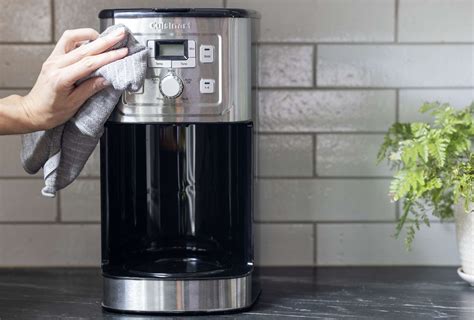How To Clean Cuisinart Coffee Maker

Are you a proud owner of a Cuisinart coffee maker and looking to maintain its optimal performance? Regular cleaning is essential to ensure your coffee maker delivers the perfect brew every time. In this comprehensive guide, we will delve into the intricacies of cleaning your Cuisinart coffee maker, covering everything from daily maintenance to deep cleaning techniques. By following these expert tips and tricks, you'll keep your coffee maker in top shape and enjoy delicious, fresh-tasting coffee.
Understanding the Importance of Cleaning

Before we dive into the cleaning process, let’s understand why regular maintenance is crucial for your Cuisinart coffee maker. Over time, coffee residue, mineral deposits, and oils can build up inside the machine, affecting its performance and the taste of your coffee. Neglecting cleaning can lead to bitter-tasting brews, clogged water lines, and even mold or bacteria growth.
By cleaning your coffee maker regularly, you can prevent these issues and extend the lifespan of your appliance. It also ensures that your coffee maker operates efficiently, saving you time and money in the long run. So, let's get started with some essential daily cleaning practices.
Daily Cleaning Routine

A consistent daily cleaning routine is key to keeping your Cuisinart coffee maker in excellent condition. Here are some simple steps to follow:
Empty and Rinse the Carafe
After each use, empty the carafe of any remaining coffee. Rinse it with warm water to remove any coffee grounds or sediment. Avoid using soap or detergent directly in the carafe, as it can leave a residue and affect the taste of your next brew.
Clean the Filter Basket
Remove the filter basket and gently tap it to dislodge any coffee grounds. Rinse it under running water to remove any remaining grounds. Ensure that you use a gentle touch to avoid damaging the basket’s fine mesh. If your filter basket has a removable lid, clean it separately.
Wipe Down the Exterior
Use a soft, damp cloth to wipe down the exterior of your coffee maker. Pay attention to the control panel and any crevices where coffee residue might accumulate. Avoid using abrasive sponges or cleaners, as they can scratch the surface.
Clean the Brew Basket
If your Cuisinart coffee maker has a removable brew basket, take it out and rinse it under running water. Ensure that all coffee grounds are removed, as they can dry and cause blockages. For a deeper clean, use a mild detergent and a soft brush to scrub away any stubborn residue.
Descale as Needed
If you live in an area with hard water, your Cuisinart coffee maker may require descaling to remove mineral deposits. Descale your machine every 3-6 months, or as recommended by the manufacturer. You can use a commercial descaling solution or a natural alternative like vinegar.
| Descaling Frequency | Recommended Timeframe |
|---|---|
| Hard Water Areas | Every 3 months |
| Moderate Water Hardness | Every 4-5 months |
| Soft Water Regions | Every 6 months |

Deep Cleaning Techniques
In addition to your daily cleaning routine, it’s essential to perform a deep clean periodically to ensure your Cuisinart coffee maker remains in optimal condition. Here’s a step-by-step guide to deep cleaning your machine:
Unplug and Disassemble
Start by unplugging your coffee maker and allowing it to cool down completely. Carefully disassemble the various components, including the carafe, filter basket, brew basket, and any removable parts.
Soak and Scrub
Fill a sink or basin with warm water and a mild detergent. Soak the removable parts, including the filter basket and brew basket, for about 15-20 minutes. Use a soft brush or sponge to scrub away any built-up residue or stains. Rinse each part thoroughly under running water.
Descale and Rinse
If your coffee maker requires descaling, follow the manufacturer’s instructions for the descaling process. Typically, you’ll need to fill the water reservoir with a descaling solution and run the machine through a brew cycle without a coffee filter. Rinse the reservoir and all components thoroughly after descaling.
Clean the Water Lines
Over time, mineral deposits can accumulate in the water lines of your Cuisinart coffee maker. To clean them, fill the reservoir with a mixture of vinegar and water (equal parts). Run a brew cycle without a coffee filter to allow the vinegar solution to flow through the lines. Rinse the reservoir and run a few cycles with clean water to remove any vinegar residue.
Dry and Reassemble
After cleaning and rinsing all components, allow them to air dry completely. Avoid using a towel or cloth, as it may leave lint or fibers behind. Once dry, reassemble your coffee maker, ensuring that all parts are securely in place.
Additional Maintenance Tips
To keep your Cuisinart coffee maker performing at its best, consider these additional maintenance tips:
- Replace Filters Regularly: Change your coffee filters after every use to prevent grounds from building up and affecting the taste of your coffee.
- Use Filtered Water: If you have hard water, using a water filter can help reduce mineral deposits and improve the taste of your coffee.
- Store Properly: When not in use, keep your coffee maker clean and dry in a cool, dry place. Avoid storing it in a damp or humid environment.
- Calibrate Temperature: Regularly check and calibrate the water temperature to ensure your coffee is brewed at the optimal temperature. Refer to your user manual for instructions.
Troubleshooting Common Issues

Despite your best cleaning efforts, issues may arise with your Cuisinart coffee maker. Here are some common problems and their solutions:
Bitter or Stale Coffee
If your coffee tastes bitter or stale, it could be due to old coffee grounds or a buildup of residue. Ensure you’re using fresh, high-quality coffee beans and clean your machine thoroughly, especially the brew basket and carafe.
Clogged Water Lines
Mineral deposits or coffee grounds can clog the water lines, causing slow brewing or water leakage. Descale your machine regularly and clean the water lines with vinegar as mentioned earlier. If the issue persists, contact Cuisinart’s customer support for further assistance.
Mold or Bacteria Growth
To prevent mold or bacteria growth, ensure you’re cleaning your coffee maker regularly, especially the carafe and filter basket. Avoid leaving water or coffee residue in the machine for extended periods. If you notice mold, clean the affected areas with a mild bleach solution and rinse thoroughly.
FAQ
How often should I clean my Cuisinart coffee maker?
+
For optimal performance, clean your coffee maker daily. Additionally, deep clean it every 3-6 months, depending on your water hardness and usage frequency.
Can I use vinegar to clean my Cuisinart coffee maker?
+
Yes, vinegar is an effective natural cleaner for coffee makers. Use a 50⁄50 vinegar-water solution to descale and clean water lines. Rinse thoroughly afterward.
What is the best way to clean the carafe?
+
Empty and rinse the carafe after each use. Avoid using soap or detergent directly in the carafe. For a deep clean, fill it with warm water and a mild detergent, then scrub with a soft brush.
How can I prevent mold or bacteria growth in my coffee maker?
+
Regularly clean and dry all components, especially the carafe and filter basket. Avoid leaving water or coffee residue in the machine for extended periods. Descale and clean the water lines periodically.
Can I use a dishwasher to clean my Cuisinart coffee maker parts?
+
While some Cuisinart coffee maker parts are dishwasher-safe, it’s recommended to hand wash them with warm water and a mild detergent. This ensures gentle cleaning and prevents potential damage to delicate components.



